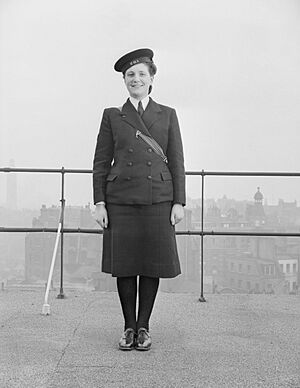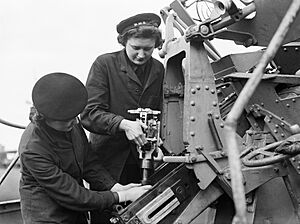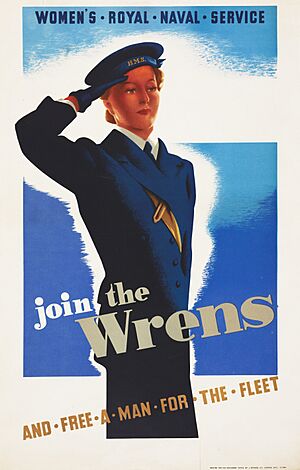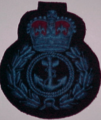Women's Royal Naval Service facts for kids
The Women's Royal Naval Service (WRNS) was a special group for women in the United Kingdom's Royal Navy. People often called them the Wrens. They first formed in 1917 during the First World War. After that war, they stopped in 1919.
The Wrens started again in 1939 when the Second World War began. They stayed active until 1993. That year, they became a full part of the Royal Navy. Wrens did many important jobs. They worked as cooks, clerks, and wireless operators. They also helped with radar, weapons, and electrical work. Some even worked on aircraft.
Contents
History of the Wrens
Starting in the First World War
The WRNS began in 1917 during the First World War. These women helped the Royal Navy. On October 10, 1918, a young Wren named Josephine Carr, who was 19, sadly died. Her ship, the RMS Leinster, was hit by a torpedo.
By the end of the war, about 5,500 women were Wrens. Around 500 of them were officers. Also, many Wrens who had worked with the Royal Naval Air Service joined the Royal Air Force. The WRNS then closed down in 1919.
The Second World War and Beyond
When the Second World War started in 1939, the WRNS was brought back. Vera Laughton Mathews became its director. The Wrens could now do even more jobs. They even flew transport planes. At its busiest in 1944, there were 75,000 active Wrens.
During the war, 102 Wrens died while serving. Another 22 were injured. A famous poster used to get women to join said: "Join the Wrens and free a man for the Fleet." This meant women could do jobs on land, letting men go fight at sea.
Wrens played a very important role at Bletchley Park. This was a secret place where codes were broken. Wrens operated special machines called bombes and the Colossus computer. These machines helped break secret codes used by the enemy.
After the Wars: A New Era
The WRNS continued after the Second World War ended. In the 1970s, people realized that women should have equal pay. Also, there was a need to end unfair treatment based on gender. This meant the WRNS and the Royal Navy would become one group.
A big change was that Wrens would follow the same rules as men. This happened by 1977. In October 1990, during the Gulf War, the ship HMS Brilliant had the first women officially serving on a warship. Later that year, Pippa Duncan became the first Wren officer to lead a Royal Navy base on land.
Finally, in 1993, the WRNS officially joined the Royal Navy. Women could then serve on navy ships as full crew members. Even today, female sailors are sometimes called "wrens" or "Jennies" by others in the navy. Before 1993, only nurses and some medical officers were directly part of the Royal Navy. All other women were Wrens.
Wrens' Uniforms
From 1939, the Wren uniform was designed by Edward Molyneux. It included a double-breasted jacket and a skirt. They also wore a shirt and tie. Junior Wrens wore hats similar to the men's hats. Senior Wrens and officers wore special three-cornered hats. In hot places, these hats had a white cover. All their badges and rank signs were blue, not gold.
See also
- Auxiliary Territorial Service
- Eswyn Lyster
- National Association of Training Corps for Girls
- Operation Outward
- Women in the World Wars
- Women's Royal Air Force (World War One)
- Women's Auxiliary Air Force
- Women's Royal Air Force
- Women's Royal Army Corps
- Military ranks of women's services in WWII
Images for kids















